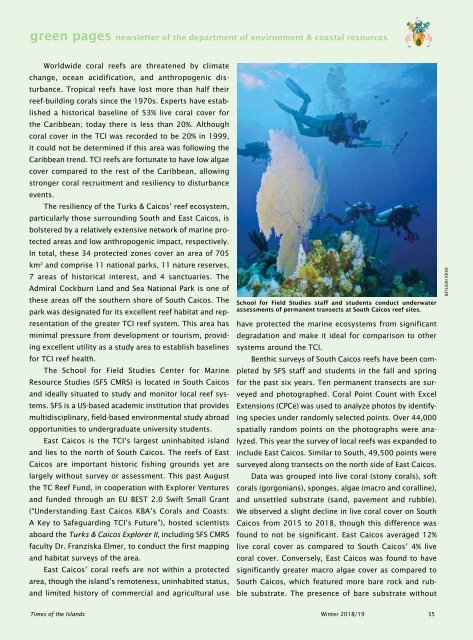Times of the Islands Winter 2018/19
Presents the "soul of the Turks & Caicos Islands" with in-depth features about local people, culture, history, environment, businesses, resorts, restaurants and activities.
Presents the "soul of the Turks & Caicos Islands" with in-depth features about local people, culture, history, environment, businesses, resorts, restaurants and activities.
- No tags were found...
Create successful ePaper yourself
Turn your PDF publications into a flip-book with our unique Google optimized e-Paper software.
green pages newsletter <strong>of</strong> <strong>the</strong> department <strong>of</strong> environment & coastal resources<br />
Worldwide coral reefs are threatened by climate<br />
change, ocean acidification, and anthropogenic disturbance.<br />
Tropical reefs have lost more than half <strong>the</strong>ir<br />
reef-building corals since <strong>the</strong> <strong>19</strong>70s. Experts have established<br />
a historical baseline <strong>of</strong> 53% live coral cover for<br />
<strong>the</strong> Caribbean; today <strong>the</strong>re is less than 20%. Although<br />
coral cover in <strong>the</strong> TCI was recorded to be 20% in <strong>19</strong>99,<br />
it could not be determined if this area was following <strong>the</strong><br />
Caribbean trend. TCI reefs are fortunate to have low algae<br />
cover compared to <strong>the</strong> rest <strong>of</strong> <strong>the</strong> Caribbean, allowing<br />
stronger coral recruitment and resiliency to disturbance<br />
events.<br />
The resiliency <strong>of</strong> <strong>the</strong> Turks & Caicos’ reef ecosystem,<br />
particularly those surrounding South and East Caicos, is<br />
bolstered by a relatively extensive network <strong>of</strong> marine protected<br />
areas and low anthropogenic impact, respectively.<br />
In total, <strong>the</strong>se 34 protected zones cover an area <strong>of</strong> 705<br />
km 2 and comprise 11 national parks, 11 nature reserves,<br />
7 areas <strong>of</strong> historical interest, and 4 sanctuaries. The<br />
Admiral Cockburn Land and Sea National Park is one <strong>of</strong><br />
<strong>the</strong>se areas <strong>of</strong>f <strong>the</strong> sou<strong>the</strong>rn shore <strong>of</strong> South Caicos. The<br />
park was designated for its excellent reef habitat and representation<br />
<strong>of</strong> <strong>the</strong> greater TCI reef system. This area has<br />
minimal pressure from development or tourism, providing<br />
excellent utility as a study area to establish baselines<br />
for TCI reef health.<br />
The School for Field Studies Center for Marine<br />
Resource Studies (SFS CMRS) is located in South Caicos<br />
and ideally situated to study and monitor local reef systems.<br />
SFS is a US-based academic institution that provides<br />
multidisciplinary, field-based environmental study abroad<br />
opportunities to undergraduate university students.<br />
East Caicos is <strong>the</strong> TCI’s largest uninhabited island<br />
and lies to <strong>the</strong> north <strong>of</strong> South Caicos. The reefs <strong>of</strong> East<br />
Caicos are important historic fishing grounds yet are<br />
largely without survey or assessment. This past August<br />
<strong>the</strong> TC Reef Fund, in cooperation with Explorer Ventures<br />
and funded through an EU BEST 2.0 Swift Small Grant<br />
(“Understanding East Caicos KBA’s Corals and Coasts:<br />
A Key to Safeguarding TCI’s Future”), hosted scientists<br />
aboard <strong>the</strong> Turks & Caicos Explorer II, including SFS CMRS<br />
faculty Dr. Franziska Elmer, to conduct <strong>the</strong> first mapping<br />
and habitat surveys <strong>of</strong> <strong>the</strong> area.<br />
East Caicos’ coral reefs are not within a protected<br />
area, though <strong>the</strong> island’s remoteness, uninhabited status,<br />
and limited history <strong>of</strong> commercial and agricultural use<br />
School for Field Studies staff and students conduct underwater<br />
assessments <strong>of</strong> permanent transects at South Caicos reef sites.<br />
have protected <strong>the</strong> marine ecosystems from significant<br />
degradation and make it ideal for comparison to o<strong>the</strong>r<br />
systems around <strong>the</strong> TCI.<br />
Benthic surveys <strong>of</strong> South Caicos reefs have been completed<br />
by SFS staff and students in <strong>the</strong> fall and spring<br />
for <strong>the</strong> past six years. Ten permanent transects are surveyed<br />
and photographed. Coral Point Count with Excel<br />
Extensions (CPCe) was used to analyze photos by identifying<br />
species under randomly selected points. Over 44,000<br />
spatially random points on <strong>the</strong> photographs were analyzed.<br />
This year <strong>the</strong> survey <strong>of</strong> local reefs was expanded to<br />
include East Caicos. Similar to South, 49,500 points were<br />
surveyed along transects on <strong>the</strong> north side <strong>of</strong> East Caicos.<br />
Data was grouped into live coral (stony corals), s<strong>of</strong>t<br />
corals (gorgonians), sponges, algae (macro and coralline),<br />
and unsettled substrate (sand, pavement and rubble).<br />
We observed a slight decline in live coral cover on South<br />
Caicos from 2015 to <strong>2018</strong>, though this difference was<br />
found to not be significant. East Caicos averaged 12%<br />
live coral cover as compared to South Caicos’ 4% live<br />
coral cover. Conversely, East Caicos was found to have<br />
significantly greater macro algae cover as compared to<br />
South Caicos, which featured more bare rock and rubble<br />
substrate. The presence <strong>of</strong> bare substrate without<br />
HEIDI HERTLER<br />
<strong>Times</strong> <strong>of</strong> <strong>the</strong> <strong>Islands</strong> <strong>Winter</strong> <strong>2018</strong>/<strong>19</strong> 35

















